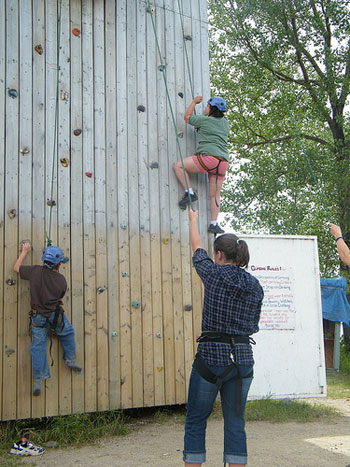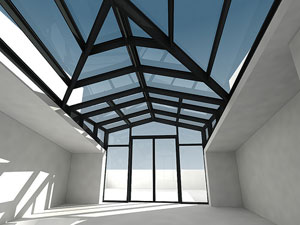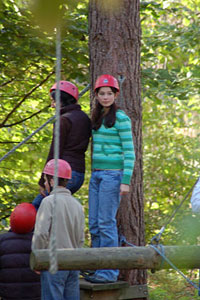
Source: Wendy and Mark attack the climbing wall
at Arlington Beach,
Jordon Cooper, Flickr
First Day of Camp
The gymnasium is crowded. Kids are everywhere, and counselors and parents mill around trying to make sense of the first day at Rock Climbing Camp. You’re walking with a friend when suddenly a girl rushes by you with an armful of papers. As she passes, she thrusts a flyer into your hands and says, “Here’s your schedule. See you in the solarium.”
Wait, you think. What just happened? You look at the paper in your hands and begin reading.
Welcome to Rock Climbing Camp!
Here is today’s schedule. Be on time to get the best seats.
Meet in the gym at 7:00 a.m. Find your counselor in the room you were assigned to during orientation. Orientation is in the Red Room at 7:15. Don’t be late! At 8:00 a.m., report to swimming pool for swimming test. Be sure you bring the health form you got during your one-on-one meeting at 7:20 a.m. 9:00–10:00 a.m. is group time. Report to the room assigned by the group leader you met with at 8:30 in the Blue Room.

Source: Huh????, Brian Mooney, Flickr
You stop reading and turn to your friend with a worried look on your face.
“What is all this?” you ask.
“Beats me,” says your friend. “I can’t understand a word it says. What do we do first? And what’s a solarium?”

Source: Solarium Interior, Caliper Studio, Flickr
Pretty confusing, isn’t it? What makes it so confusing? Do you suppose it has anything to do with the way the schedule was written, jumping around in time the way it does, first telling you where to go at 8 a.m., then to bring something to a meeting that you should have gotten at a previous meeting at 7:20 a.m.? Can you see how easy it is to get lost in all the words the author uses?
There must be a better way to get this information across, right? How about if it were presented differently, like maybe in a list or a table? Look at the graphic below representing the same information presented above.
| Time | Who Attends | Location | Event |
|---|---|---|---|
| 7:00 A.M. | All campers | Gym | Welcome |
| 7:15 | All campers | Red Room | Orientation |
| 7:30 | All campers | TBD | One to One Meetings with Counselors |
| 8:00 | All campers | Swimming Pool Bring health form |
Swimming Test |
| 8:45 | All campers | Blue Room | Meet with Group Leader |
| 9:00–10:00 | All campers | Determined by Group Leader in Blue Room Meeting | Group Time |

Source: Orientation Fall 2012, Thompson Rivers University, Flickr
Based on the information presented in the table above, answer the two questions that follow. Hint: The information included in a graphic representation is a powerful way to present information but does not necessarily tell the reader everything that is in the text.


Source: iStockphoto.com
- If your friends tell you that you don’t look your best when your hair is all wet and slicked down, when would you NOT want to see them?
- Where is the solarium?

Source: Huh? Canz climb now?!, Alex Hansford,
Flickr
You can see how the same information is clearer when expressed in a graphic representation than when presented in words alone. In this lesson, you will learn how to evaluate the clarity of such graphics as tables, graphs, and diagrams.